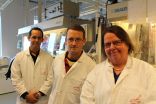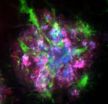(Press-News.org) Solving global challenges in food security, emerging diseases and biodiversity loss requires evolutionary thinking, argues a new study published online in Science Express that was co-authored by Bruce Tabashnik of the University of Arizona College of Agriculture and Life Sciences.
For the first time, an international team of nine scientists has reviewed progress in addressing a broad set of challenges in agriculture, medicine and environmental management using approaches that consider evolutionary histories and the likelihood of rapid adaptation to human activities.
The study finds an urgent need for better implementation of evolutionary approaches — for example, to combat the problem of escalating resistance to antibiotics and pesticides. Furthermore, current efforts are found insufficient to reduce the accumulating costs from chronic disease and biodiversity loss, two crises ultimately caused by exposure to food and environments to which people and threatened wildlife are poorly adapted.
"Evolutionary principles provide insights for addressing some critical threats the world is facing now," said Tabashnik, who heads the UA's Department of Entomology and also is a member of the UA's BIO5 Institute. "An evolutionary perspective can give us effective new ways to deal with problems from agricultural pests, pathogens such as the Ebola virus, to cancer, antibiotic resistance and endangered species."
Tabashnik and his colleagues at UA have been at the forefront of research aiming to provide farmers with sustainable control of crop pests that reduces reliance on broad-spectrum insecticide sprays. An important advance in this effort is genetic engineering of cotton and corn to produce proteins derived from the widespread soil bacterium Bacillus thuringiensis, or Bt. Bt proteins kill certain insect pests but are harmless to most other creatures, including people. These environmentally friendly toxins have been used for decades in sprays by organic growers and since 1996 in engineered Bt crops by mainstream farmers.
Integration of Bt cotton plants with other tactics has revived Arizona's cotton industry, which was all but wiped out by invasive pest species. In particular, the refuge strategy based on evolutionary principles is credited with preventing resistance to Bt cotton by pink bollworm in Arizona for more than a decade.
Refuges consist of plants that do not have a Bt toxin gene and thus allow survival of insects that are susceptible to the toxin. Farmers plant refuges near Bt crops to produce enough susceptible insects to make it unlikely two resistant insects will mate and produce resistant offspring.
According to Tabashnik, the refuge strategy worked brilliantly against the pink bollworm in Arizona, where the pest had plagued cotton farmers for a century but is now scarce. In India, however, where farmers did not plant refuges, pink bollworm rapidly evolved resistance to Bt cotton.
"This particular success in Arizona can spur related evolutionary solutions in other regions and in other sectors," Tabashnik said.
According to the paper, the refuge strategy might even yield more effective cancer treatments. The idea is that portions of tumors with low vascularization and consequently low delivery of chemotherapeutic drugs may serve as refuges sustaining tumor cell lines that have not yet become resistant to chemotherapy.
"Compared with typical failures when oncologists try to eradicate a patient's cancer with high drug doses, lower doses could be more successful if they favor survival of chemosensitive cell lines that can outcompete chemoresistant lines," the authors write.
Other scientists at UA also are leaders in using evolutionary approaches to address global challenges. The research of Michael Worobey, a professor in the UA's Department of Ecology and Evolutionary Biology has produced breakthroughs in understanding AIDS, flu epidemics and obesity.
Researchers with the UA's Arizona Genomics Institute and the iPlant Cooperative have deciphered the genetic codes of crop plants, providing breeders with tools to produce varieties that have enhanced nutritional value and are better suited to cope with climate change. Most recently, an international research team led AGI Director Rod Wing sequenced the complete genome of African rice.
"Applying evolutionary biology has tremendous potential, because it takes into account how unwanted pests or pathogens may adapt rapidly to our interventions and how highly valued species including humans on the other hand are often very slow to adapt to changing environments through evolution," said study co-author Peter Søgaard Jørgensen, a biologist at the Center for Macroecology, Evolution and Climate at the University of Copenhagen. "Not considering such aspects may result in outcomes opposite of those desired, making the pests more resistant to our actions, humans more exposed to diseases and vulnerable species less able to cope with new conditions."
"To succeed in avoiding such unwanted outcomes, however, we need to learn from successes and progress in all fields using evolutionary biology as a tool. Currently there is no such coordination," said Scott P. Carroll, lead author and biologist at the University of California Davis and director of the Institute for Contemporary Evolution.
"Applied evolutionary biology uses principles common to all areas of biology, and because of this, progress in one area may often enable solutions in others," the paper concludes. "New approaches in this developing field may best be generated and assessed through collaborations that span disciplinary boundaries."
INFORMATION:
Tabashnik's work on the paper was supported by the U.S. Department of Agriculture's Biotechnology Risk Assessment Grants Program.4
Evolutionary biology: It's not just for textbooks anymore
UA scientists are on the leading edge of a new approach to tackle global challenges in food security, emerging diseases and biodiversity loss; Arizona's cotton crop provides evidence of their success
2014-09-29
ELSE PRESS RELEASES FROM THIS DATE:
IMPRESS trial data on continuing tyrosine kinase inhibitor therapy after resistance development in lung cancer reported
2014-09-29
Patients whose lung cancer has developed resistance to the drug gefitinib experience no statistically significant improvement in progression-free survival from continued treatment with the drug in addition to chemotherapy, a phase III trial presented at the ESMO 2014 Congress has shown.
The IMPRESS trial is a randomised phase III study that compared continuation of gefitinib in addition to chemotherapy against chemotherapy alone in patients with lung cancer that carried mutations in the EGFR cell surface receptor.
Gefitinib is a type of drug known as a tyrosine kinase ...
Pertuzumab adds 16 months survival benefit to trastuzumab and chemo treatment for HER2-positive breast cancer
2014-09-29
Patients with HER2-positive breast cancer that has spread to other parts of their body live around 16 months longer if treated with a combination of pertuzumab, trastuzumab and chemotherapy compared to those treated with trastuzumab and chemotherapy alone, updated results from the CLEOPATRA study reveal.
CLEOPATRA was a pivotal phase III study where researchers evaluated the safety and efficacy of pertuzumab, trastuzumb and chemotherapy in 808 patients with previously untreated HER2-positive metastatic breast cancer. HER2-positive metastatic breast cancer has historically ...
Adding cediranib to chemo improves progression-free survival for meta or recurrent cervical cancer
2014-09-29
For patients with cervical cancer that has recurred after treatment or has spread elsewhere in the body, adding the experimental drug cediranib to standard chemotherapy improves tumour shrinkage and adds a modest improvement in progression-free survival, researchers report at the ESMO 2014 Congress in Madrid.
In Europe, about 70% of patients with cervical cancer are cured by either surgery or chemo-radiotherapy. Those patients with recurrent or secondary cancer have a very poor outlook. Only about 20-30% have tumour shrinkage after conventional chemotherapy and survival ...
Many patients lack information about the use of targeted therapies, oncologists say
2014-09-29
More than three quarters of oncology specialists in Europe, South America and Asia believe their patients are not always well enough informed about the treatment options available to them, survey results have revealed at the ESMO 2014 Congress in Madrid, Spain.
The results come from an online survey of 895 doctors from 12 countries in Europe, South America and Asia. All were practicing oncology specialists, with more than three years' experience, treating more than fifteen patients a month.
While 82% of those surveyed believed that deciding on a course of treatment ...
Under-representation of women in oncology leadership positions
2014-09-29
A growing number of oncologists in Greece are female, but women continue to be under-represented in leadership positions, according to a survey reported at the ESMO 2014 Congress.
"In Greece, and across Europe, women oncologists still find it hard to access leadership or academic positions," said Dr Helena Linardou, Associate Director of the 1st Department of Oncology at the Metropolitan Hospital, Athens, Greece, who presented the survey results at the congress.
"Women are indeed increasingly choosing oncology specialties in Greece, however, most decision-making posts ...
Is expressive suppression effective in reducing negative emotion?
2014-09-29
A recent study based on a Chinese sample gives an answer to this question. The research shows that in Chinese culture, emotion- expressive suppression is not only able to dampen negative emotion effectively, but also dampen negative emotion faster than Cognitive reappraisal. This sheds much light on how to quickly regulate negative emotion in urgent situations, particularly when people from East-Asian cultures are concerned.
This study has been published in SCIENCE CHINA: Life Sciences (IN CHINESE) , which is titled "The efficiency of negative emotion regulation: ...
Using the brain to forecast decisions
2014-09-29
You're waiting at a bus stop, expecting the bus to arrive any time. You watch the road. Nothing yet. A little later you start to pace. More time passes. "Maybe there is some problem", you think. Finally, you give up and raise your arm and hail a taxi. Just as you pull away, you glimpse the bus gliding up. Did you have a choice to wait a bit longer? Or was giving up too soon the inevitable and predictable result of a chain of neural events?
In research published on 09/28/2014 in the journal Nature Neuroscience, scientists show that neural recordings can be used to forecast ...
Smart, eco-friendly new battery to solve problems
2014-09-29
Present-day lithium batteries are efficient but involve a range of resource and environmental problems. Using materials from alfalfa (lucerne seed) and pine resin and a clever recycling strategy, Uppsala researchers have now come up with a highly interesting alternative. Their study will be presented soon in the scientific journal ChemSusChem.
'We think our discovery can open several doors to more environment-friendly, energy-efficient solutions for the batteries of the future,' says Daniel Brandell, Associate Professor at the Department of Chemistry, Uppsala University, ...
Protein that causes frontotemporal dementia also implicated in Alzheimer's disease
2014-09-29
SAN FRANCISCO, CA—September 28, 2014—Researchers at the Gladstone Institutes have shown that low levels of the protein progranulin in the brain can increase the formation of amyloid-beta plaques (a hallmark of Alzheimer's disease), cause neuroinflammation, and worsen memory deficits in a mouse model of this condition. Conversely, by using a gene therapy approach to elevate progranulin levels, scientists were able to prevent these abnormalities and block cell death in this model.
Progranulin deficiency is known to cause another neurodegenerative disorder, frontotemporal ...
Predicting landslides with light
2014-09-29
WASHINGTON, Sept. 29, 2014—Optical fiber sensors are used around the world to monitor the condition of difficult-to-access segments of infrastructure—such as the underbellies of bridges, the exterior walls of tunnels, the feet of dams, long pipelines and railways in remote rural areas.
Now, a team of researchers in Italy are expanding the reach of optical fiber sensors "to the hills" by embedding them in shallow trenches within slopes to detect and monitor both large landslides and slow slope movements. The team will present their research at The Optical Society's (OSA) ...
LAST 30 PRESS RELEASES:
Manta rays create mobile ecosystems, study finds
Study: Mixed results in using lipoic acid to treat progressive multiple sclerosis
Norbert Holtkamp appointed director of Fermi National Accelerator Laboratory
New agentic AI platform accelerates advanced optics design
Biologists discover neurons use physical signals — not electricity — to stabilize communication
Researchers discover that a hormone can access the brain by hitchhiking
University of Oklahoma researcher awarded funding to pursue AI-powered material design
Exploring how the visual system recovers following injury
Support for parents with infants at pediatric check-ups leads to better reading and math skills in elementary school
Kids’ behavioral health is a growing share of family health costs
Day & night: Cancer disrupts the brain’s natural rhythm
COVID-19 vaccination significantly reduces risk to pregnant women and baby
The role of vaccination in maternal and perinatal outcomes associated with COVID-19 in pregnancy
Mayo Clinic smartwatch system helps parents shorten and defuse children's severe tantrums early
Behavioral health spending spikes to 40% of all children’s health expenditures, nearly doubling in a decade
Digital cognitive behavioral treatment for generalized anxiety disorder
Expenditures for pediatric behavioral health care over time and estimated family financial burden
Air conditioning in nursing homes and mortality during extreme heat
The Alps to lose a record number of glaciers in the next decade
What makes a good proton conductor?
New science reporting guide published for journalists in Bulgaria
New international study reveals major survival gaps among children with cancer
New science reporting guide published for journalists in Turkey
Scientists develop a smarter mRNA therapy that knows which cells to target
Neuroanatomy-informed brain–machine hybrid intelligence for robust acoustic target detection
Eight SwRI hydrogen projects funded by ENERGYWERX
The Lundquist Institute and its start-up company Vitalex Biosciences Announces Strategic Advancement of Second-Generation fungal Vaccine VXV-01 through Phase 1 Trials under $40 Million Competitive Con
Fine particles in pollution are associated with early signs of autoimmune disease
Review article | Towards a Global Ground-Based Earth Observatory (GGBEO): Leveraging existing systems and networks
Penn and UMich create world’s smallest programmable, autonomous robots
[Press-News.org] Evolutionary biology: It's not just for textbooks anymoreUA scientists are on the leading edge of a new approach to tackle global challenges in food security, emerging diseases and biodiversity loss; Arizona's cotton crop provides evidence of their success




